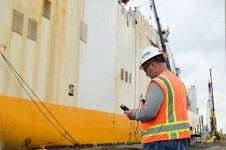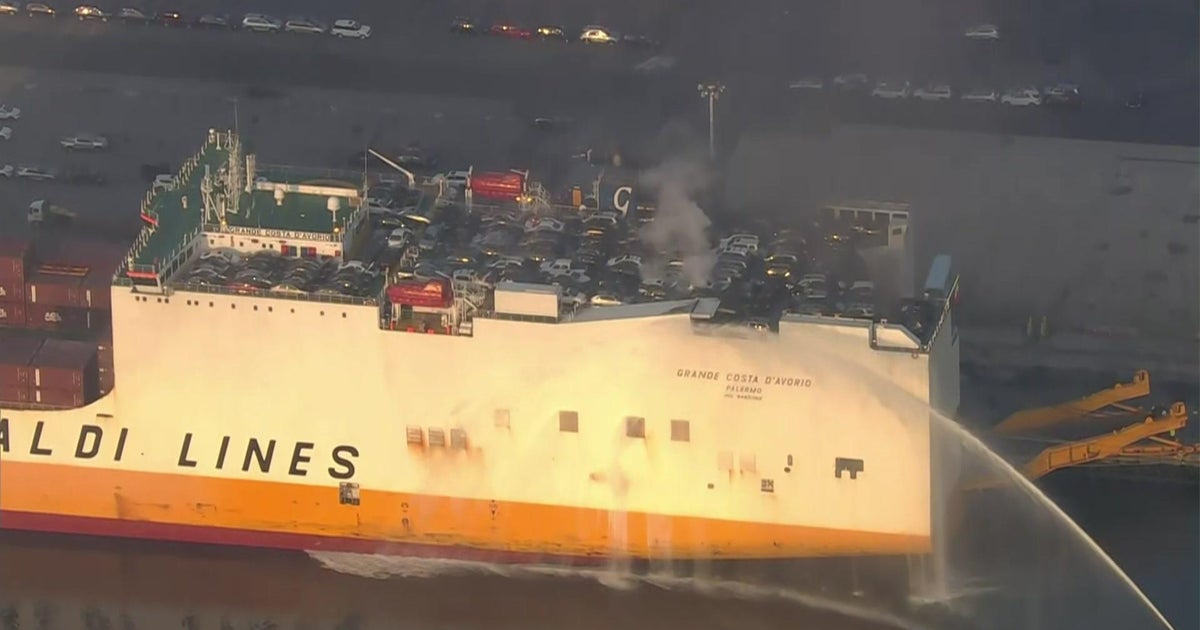PROGRESS REPORT PROVIDED BY THE US COAST GUARD:
July 8, 2023
UPDATE 1: Unified Command continues response to fire aboard motor vessel Grande Costa D’Avorio at Port Newark


 To view and download the videos, click the above thumbnails.
To view and download the videos, click the above thumbnails.
PORT NEWARK, New Jersey – The Unified Command consisting of the U.S. Coast Guard, Port Authority of New York and New Jersey, Newark Fire Department, and Gallagher Marine Systems is continuing its response to the fire aboard the vessel at Port Newark.
“Thanks to the dedication of the responders on scene, we have made considerable progress overnight,” said Capt. Zeita Merchant, the captain of the port of New York and New Jersey and federal on-scene coordinator. “There is still significant work to do, and challenges ahead as we get closer to an end state, but the ability for agencies at all levels to work together in our response is a testament to our shared commitment and singular vision to ensuring the responders, the community, and the port remains safe.” added Capt. Zeita Merchant.
As of Saturday afternoon, the fire is contained on the 11th deck and is being suppressed and no longer spreading to other areas of the vessel. Responders are also continuing dewatering operations on the lower decks. Due to successful dewatering, the vessel has been further stabilized. The vessel will continue to list between one and two degrees to starboard as a way to accelerate the dewatering process.
Air monitoring specialists, contracted by Gallagher Marine Systems, continues to perform air monitoring around the vessel and in the surrounding areas. Additional air monitoring devices are being deployed to extend the footprint of the monitored area. No detections above hazardous levels in the surrounding areas have been observed since the monitoring began on July 6th at 9pm.
“Public and responder safety remain a top priority for the Unified Command and even thought the progress made on fire suppression on the vessel is a significant victory, we will continue to deploy air and water monitoring resources," said Kevin S. Perry, Vice President of Emergency Response, Gallagher Marine Systems.
If people in the surrounding areas and communities are concerned about air quality, we urge them to review the DEP and EPA air quality monitoring resources, listed below, which can be used by the public for general awareness about current air quality in their community.
Air quality forecasting resources:
New Jersey Environmental Protection Agency air monitoring site:
https://www.airnow.gov/
New Jersey Department of Environmental Protection air monitoring site:
https://nj.gov/dep/airmon/
There is no visible pollution or sheen in the water, but it is discolored from soot. Water samples were collected on Friday and test results from those samples are expected to be returned within 48 hours.
The City of Newark and the Newark Fire Department continues to work closely with the Unified Command.
“We are pleased to report that each of the Newark Fire Captains who were injured while fighting the fire at Port Newark have been released from the hospital,” said Newark Public Safety Director Fritz Fragé. “The Newark Fire Captain who suffered burns from water accumulated on the cargo ship’s floor is reportedly in stable condition and will complete his recovery at home,” he added.
The U.S. Coast Guard is currently enforcing a security zone within the Port Newark Channel and the Port Newark Channel from Berth 18 inward remains closed. The Port of New York and New Jersey remains open.
“The Port Authority continues to remain focused on maintaining operations across the port,” said Port Authority Port Director Bethann Rooney. “We thank our partners in the Unified Command for their steadfast support throughout the response efforts.”
A formal investigation will be conducted to identify what caused the fire and subsequent fatalities, and all investigative parties at the federal, state, and local levels as well as the owners, are working closely together during this process.












